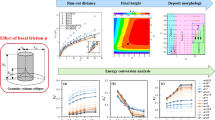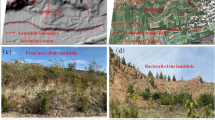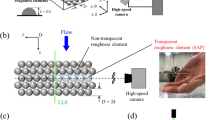Abstract
Simple geometric models of ice surface shapes and equations of motion of objects on these surfaces can be used to explain ejection of sliders from ice tracks. Simulations employing these explain why certain design features can be viewed as proximate causes of ejection from the track and hence design flaws. This paper studies the interaction of a particle model for the luge sled (or its right runner) with the ice fillet commonly connecting inside vertical walls in turns to the flat track bottom. A numerical example analyzes the 2010 luge accident at the Vancouver Olympics. It shows that this runner-fillet interaction, and specifically the fillet’s positive curvature up the inside wall, can cause a vertical velocity more than sufficient to clear the outside exit wall. In addition the negative curvature of the fillet along the track and the large vertical velocity, explain loss of fillet or wall contact and slider ejection. This exposes the fillet along inside walls as a track design flaw. A more transparent track design and review process could provide more complete and thorough design and verification scrutiny by competent scientists and engineers without financial involvement or conflicts of interest and potentially lead to safer future designs.








Similar content being viewed by others
References
International Luge Federation (2010) Official report to the International Olympic Committee on the accident of Georgian athlete, Nodar Kumaritashvili, at the Whistler Sliding Center, Canada, on February 12, 2010, during official luge training for the XXI Olympic Winter Games. http://www.fibt.com/fileadmin/Rules/International_Rules_-_Bobsleigh_english_ver_1-1_16092007.pdf. Accessed Dec 2011
Pawlowski T (2010) Coroner’s report into the death of Kumaritashvili, Nodar. British Columbia Ministry of Public Safety and Solicitor General. Case No: 2010-0269-0002
Whistler Sliding Center (2010) Request for expressions of interest for an evaluation of sled trajectories within the track of the Whistler Sliding Centre. 1 Dec 2010
Zahavich ATP, Bromley R, Montgomery J, Bernamann M, MacKenzie S, Cripton P (2012) Whistler Sliding Centre sled trajectory and track construction study: an independent safety audit as recommended by the BC coroner. http://www.whistlersportlegacies.com/reports/safetyaudit. Accessed Dec 2012
The New York Times (2010) Luge crash at the Olympics. http://www.nytimes.com/interactive/2010/02/12/sports/olympics/LUGEDEATH.html. Feb 2010
The Huffington Post (2010) Nodar Kumaritashvili crash VIDEO: luge slider DEAD in Olympics accident. http://www.huffingtonpost.com/2010/02/12/nodar-kumaritashvili-cras_n_460474.html. Feb 2010
International Luge Federation (2010) IRO International Luge regulations—artificial track. International Luge Federation
International Bobsleigh and Skeleton Federation (2007) International Rules, Bobsleigh. http://www.fibt.com/fileadmin/Rules/International_Rules_-_Bobsleigh_english_ver_1-1_16092007.pdf. Accessed Dec 2011
Faux ID, Pratt MJ (1979) Computational geometry for design and manufacture. Ellis Horwood Ltd, Chichester, pp 105–113
Hubbard M, Kallay M, Rowhani P (1989) Three dimensional bobsled turning dynamics. Int J Sports Biomech 5:222–237
Kelly A, Hubbard M (2000) Design and construction of a bobsled driver training simulator. Sports Eng 3:13–24
Zhang YL, Hubbard M, Huffman RK (1995) Optimum control of bobsled steering. J Optim Theory Appl 85:1–19
Gallier JA (2002). http://www.seas.upenn.edu/cis70005. Accessed Dec 2011
Kane TR, Levinson DA (1985) Dynamics: theory and applications. McGraw-Hill, New York
Mössner M, Hasler M, Schindelwig K, Kaps P, Nachbauer W (2011) An approximate simulation model for initial luge track design. J Biomech 44(5):892–896
Balakin VA, Smirnov VN, Pereverzeva OV (1988) Sliding of sled runner over ice. Friction Wear 9(2):266–273
Acknowledgments
The author gratefully acknowledges ongoing discussions regarding the video footage with Andy Ruina and Les Schaffer during the ten days after the accident. These were valuable in clarifying the sequence of events and the facts of the accident itself. Also acknowledged are helpful discussions with and suggestions from Lyn Taylor, Michael Drapack, Frank Masley, Jeff Kluewer, and Steve Tracy.
Author information
Authors and Affiliations
Corresponding author
Appendix A
Appendix A
We begin with an analytic approximation for the toroidal fillet surface connecting the cylindrical inner wall and the planar floor and then present the equations of motion for a particle travelling on this specific surface, based on equations for motion of a particle on a general 2-D surface [10].
1.1 Toroidal fillet geometry
At the location of the Olympic accident the track slope β = 0 and the fillet surface is well approximated by a torus (Theory similar to that presented in this paper can be used in the more general situation where β ≠ 0 and the fillet shape is a helical tube rather than a torus). When the floor slope angle β = 0, the implicit equation of the torus is
The xyz coordinates of a point on the fillet are given by
Equations 7 emphasize that the position vector to an arbitrary point on the torus is a function \({\mathbf{r}}={\mathbf{r}}(u,v)\) of the two surface (angle) parameters u and v [9]. The terminology of Faux and Pratt [9] is followed closely here.
The velocity vector lies along a tangent to the surface
where
and
The analytic expression for the torus surface makes it possible to compute analytically its partial derivatives with respect to u and v. Specifically,
and
The first and second fundamental matrices \({\mathbf{G}}\) and \({\mathbf{D}}\) of the toroidal surface are functions of the partial derivatives above:
and
and where the unit surface normal \({\mathbf{n}}\) is given by
The negative sign in Eq. 18 is chosen so that \({\mathbf{n}}\) points away from the ice surface and into the track (and the torus) interior.
The normal curvature κ n of the torus in the tangent direction \({\mathbf{v}}={\bf A}{\dot{\bf{u}}}\) is defined as the curvature of the curve of intersection of the surface and the plane containing the tangent vector \({\mathbf{v}}\) and the surface normal \({\mathbf{n}}\) [9]. It is a ratio of quadratic forms in \({\dot{\mathbf{u}}}\) with the matrices \({\mathbf{G}}\) and \({\mathbf{D}}\) as coefficients [9]
The directions in the surface at the point (u, v) for which the normal curvature κ n becomes a minimum and maximum are called the principal directions of normal curvature, and the corresponding normal curvatures κ 1 and κ 2 are called principal curvatures. The product of the principal curvatures, the Gaussian curvature K, is also related to matrices \({\mathbf{G}}\) and \({\mathbf{D}}\) through
Due to symmetry, one of the principal curvatures of a torus is the inverse of the minor radius κ 2 = 1/r. Hence the other principal curvature is given by \(\kappa_1=-\sin v /(R-r\sin v), \) the negative sign indicating that along the (longitudinal) first principal direction in question, the surface “falls away” from the inward pointing normal vector n.
Normal curvature at a specific point (u, v) varies continuously with direction ϕ according to Euler’s formula [13]
where ϕ is the angle measured in the tangent plane about n from the first principal direction (of increasing “longitude”) corresponding to curvature κ 1.
Because R ≫ r, when the parameter v > 0 the Gaussian curvature is negative and there is a direction in the surface tangent plane at critical angle ϕ c for which the normal curvature vanishes. This value of ϕ c can then be calculated by substitution of κ n = 0 into Eq. 21.
This direction separates those directions for which κ n > 0 and surface contact is maintained at all speeds from those in which κ n < 0 and loss of contact is possible at some speed.
1.2 Equations of motion
As the particle slides along the surface the parameters u and v and their derivatives change according to Newton’s laws [10]. Here the generalized speeds [14] are chosen to be the angular rates \({\dot{u}}\) and \({\dot{v}}, \) the two components of \({\dot{\mathbf{u}}}.\)
Although in general motion of luge, bobsled and skeleton on ice tracks all forces (including weight, normal force, aerodynamic lift and drag, ice friction and steering forces) are important for accurate prediction [10], in the fillet contact problem considered here the surface normal force resulting from normal acceleration due to fillet curvature is enormous. Further, the aerodynamic and friction forces are typically an order of magnitude smaller than the weight, the coefficient of friction and drag area being of the order of 0.01 and 0.05 m2, respectively [15, 16]. Thus only the first two of these forces, weight and normal force, are included in the present analysis; the former only to ascertain its role in delaying loss of surface contact, and the latter because the vertical component of its impulse causes the vertical velocity required for ejection.
Similar to the development in the Appendix of [10], the equations of motion for a particle sliding on the surface become
where
and where \({\mathbf{k}}\) denotes the unit vector in the vertical direction. Note that Eq. 23 is independent of mass since each term contains the factor m.
The normal force \({\mathbf{N}}\) is a constraint force that insures that the luge remains in contact with the ice surface (when the normal curvature is positive). \({\mathbf{N}}\) vanishes when the normal component of the weight mg is insufficient to supply the negative normal acceleration (associated with negative normal curvature) to maintain surface contact. Loss of surface contact is synonymous with \({\mathbf{N}}\) vanishing. When \({\mathbf{N}}\) is nonzero its magnitude is directly proportional to the mass and is given by
The fillet and the inner wall surfaces are, generally speaking, the only portions of the entire ice surface for which there exist sliding directions in which the normal curvature is negative. Thus, assuming that the vertical component of the unit normal is positive (and the track surface doesn’t go upside down) so that the gravity force acts to hold the slider on the surface, they are the only portions of the surface from which launch into flight can occur. To the extent that inner walls are vertical, sliding on these is impossible since they turn away from the interior (the normal curvature is always negative or zero) and launch always occurs instantaneously when contact occurs with an inner wall. The fillet, when it exists at the base of an inner wall, is the entrée to the wall and, even though contact and a positive normal force may persist throughout the entire sliding path on the fillet, the path eventually leads to the wall segment of the surface and certain launch. This is why the existence of a fillet at the base of an inner wall is a track design flaw.




